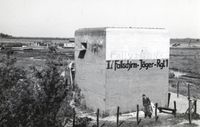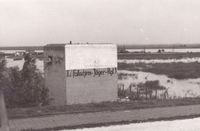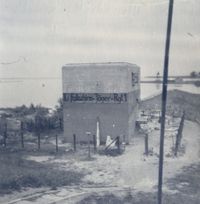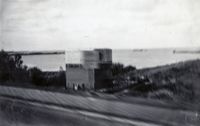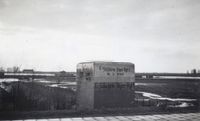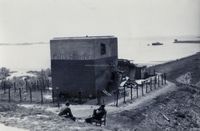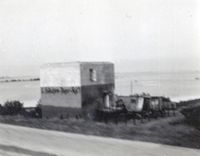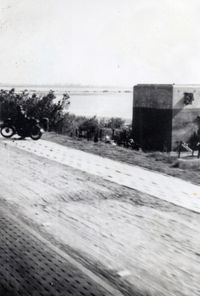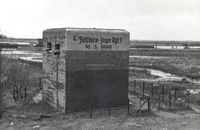River casemate I and II - Willemsdorp.
Due to the considerable number of photos we have collected of Rivierkazemat II in Willemsdorp, and its extensive history, a decision has been made to create a separate page specifically dedicated to Rivierkazemat II. Since the most significant part of the bunker's history occurred during May 1940, it has been decided to include this page under the "May 1940" section. Not all photos can be confirmed as being taken in May 1940. However, since all the photos are labeled with II/Fallschirmjäger Regiment 1, it is likely that they were taken shortly after May 1940.
If any future photos of Rivierkazemat I or other fortifications in Willemsdorp and Moerdijk are added to the collection (which we are still searching for), they will also be included here.
The Rivierkazemat II.
In the mid-1930s, the Netherlands began to realize that Europe might be heading towards a new war, and that this time, the country might not be able to remain neutral. Mobilization was announced, and fortifications and bunkers were constructed throughout the country to withstand a potential German attack. The Moerdijk bridges, the crucial connection between the provinces of Holland and North Brabant, were no exception. In 1936, two River Casemates of Type B were built in Willemsdorp, with the loopholes aimed at the two bridges. Rivierkazemat I was constructed near the railway and aimed at the railway bridge, while Rivierkazemat II was built right next to the entrance of the road bridge, targeting the road bridge.
Both bunkers were equipped with a 5 no 2 cannon and a heavy machine gun, providing substantial firepower. The only disadvantage, which would prove to be fatal later on, was that the loopholes were aimed at the bridges, making it difficult to fire towards Willemsdorp. This decision was not entirely illogical at the time, as the use and impact of paratroopers were not yet understood, and it was expected that the enemy would approach from Germany through North Brabant. *1
The occupation of both River Casemates in May 1940 was carried out by units of the Police Troops. They were responsible for operating the 5 no 2 cannons, while the heavy machine guns were operated by soldiers from the machine gun section of the 3rd Border Battalion (both bunkers together forming one section of MC-3GB).
Furthermore, not only the garrison was present at Rivierkazemat II on May 10th. The bunker housed fuses for blowing up the road bridge and a reserve stockpile of 1250 kg of explosives. However, the explosive charges were not armed. This decision was made based on the assumption that the enemy would come from Germany, allowing ample time to destroy the bridge. Once again, the presence of paratroopers was not accounted for. *2
On the morning of May 10, 1940, Rivierkazemat II was under the command of Sergeant-Major van Almkerk of the Police Troops. Using a 5 no 2 cannon and machine guns, fire was directed towards the German paratroopers attempting to capture the bridge. The German paratroopers managed to reach the bunker through the water and ordered the Dutch garrison to surrender. It became painfully clear at that moment that loopholes at the rear of the bunker would have been extremely useful. However, the Dutch did not surrender without a fight. The Germans threatened to blow up the bunker, but the Dutch soldiers continued to resist. The Germans attempted to smoke out the Dutch garrison through the ventilation pipes but were unsuccessful as the Dutch soldiers donned their gas masks. Eventually, the paratroopers blew the door off its hinges and threw grenades inside. Knowing that there were 1250 kg of explosives in the bunker, Sergeant-Major van Almkerk decided to surrender with his men.
In the various photos from the collection of Rivierkazemat II, you can see that the Fallschirmjägers of the 2nd battalion of FJR 1 left their mark. In the first photo, there are still many bullet impacts visible above the loopholes. In the third and last two photos, it is clearly visible that the door is missing. *3
The next photo (8) shows the River Casemate from a slightly different angle. What is interesting to see here is the white cloth in one of the gun slits. It is possible that it was placed there by the Dutch occupation during surrender. However, it is more likely that the German paratroopers placed the cloth there to indicate that the bunker was no longer occupied by Dutch troops. The photo was most likely taken shortly after or even during the May days of 1940.
What is even more apparent here than in the other photos are the numerous bullet impacts around the gun slits. It must have been a fierce battle to take over this bunker. We can also see dense vegetation, which was probably not beneficial to the field of fire for the Dutch occupation, at least in that direction. Finally, we see a German motorcycle. It appears that a German motorcyclist or "kradschütze" briefly stopped to capture this bunker on camera. The following photo (11) seems to capture the same scene from a different angle. In photo 12 and 13, particularly 13, it is clearly that another type of P- casemate has been built on the landward side behind the river casemate. The P-casemate is disguised as a small house. It is a sharp and detailed shot of River Casemate II.
River Casemate I.
The River Casemate Willemsdorp I, shown in the photo below, was also built in 1936. Like River Casemate II, it was a Type B River Casemate. Casemate I was located right next to the railway and was occupied by five men under the command of Corporal Kwak from the Police Troops at the time of the invasion. Due to its proximity to the landing site of the German paratroopers and with the gun slits facing the railway, it was nearly impossible for the Dutch occupants to effectively fire at the paratroopers who had approached from outside the range of the casemate and were at a short distance. The German paratroopers were able to effectively fire at the gun slits, forcing the casemate's crew to descend to the ground level. Hand grenades were thrown inside through the gun slits but had no effect. Meanwhile, the Germans had captured two families of two railway employees who both had houses near the signal and watchhouse. The two families had taken shelter in the hiding place located near the signalman's house. The sixteen-year-old son of one of the families, the Huisman family, was taken by a German non-commissioned officer to the back door of the casemate, where he had a pistol pointed at his stomach. Upon the boy's request, the occupants of the casemate, whom the boy knew well, saw no other choice but to surrender under the German's coercion. This incident easily neutralized the occupation of the casemate near the railway. *5
In the photo, it can be seen that the bunker is marked with text. It reads:
Fallschirmjäger 12. kompanie 2. Zug Pfingsten 1940 Holland.
The Casemate was not captured by this company but presumably by men from the 5th or 6th company. The text was likely added only for the sake of the photo. The barrel of cannon 5 no. 2 can still be seen in the right gun slit. The railway is located just to the right of the casemate.
Below is a German recording of the Dutch defense works between the Moerdijk bridges and the Tweede Tol. They are also clearly visible in the propaganda film "Sprung in den Feind." This particular structure is an earth bunker of Dutch make. It is unclear whether these bunkers were occupied during May 1940. Most likely not, considering the fact that the defense at the Tweede Tol and the Dekkingsdetachement ( cover detachment) in Willemsdorp were almost completely caught off guard.
©2017-2025 :Https://www.Dordrechtindeoorlog.nl: ( There is a copyright on the content of this website. This content is not to be shared, duplicated or published withouth the explicit permission of the author of this website. If you have any requests you can email to: Info@Dordrechtindeoorlog.nl or look on : www.dordrechtindeoorlog.nl/termsofuseforthecontentonthiswebsite.
*1 Source: ZuidfrontHolland1940 - Versterkingen en Voorzieningen.
*2 Source: ZuidfrontHolland1940 - Proloog vak Wieldrecht.
*3 Source: ZuidfrontHolland1940 - Willemsdorp 10 mei 1940.
*4 Source: The book: Opmars naar Rotterdam - De luchtlanding by E.H. Brongers.
*5 Source: ZuidfrontHolland1940- Willemsdorp- De Kazematten.
